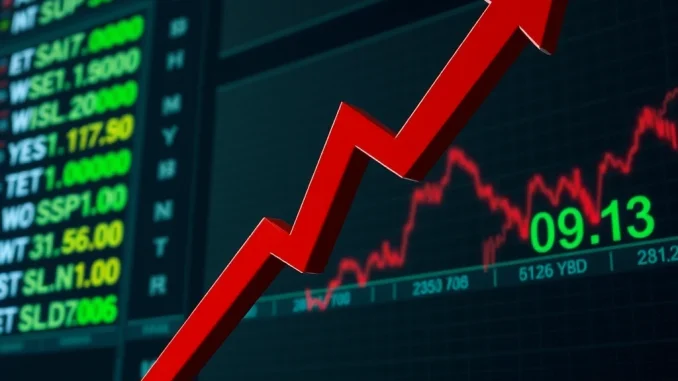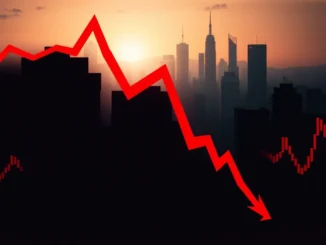
Brace yourselves, investors! The U.S. stock market has just opened, and it’s painting a sea of red. Are you watching your portfolio and wondering what’s going on? You’re not alone. Today’s market open is signaling a downturn across major indices, leaving many traders and long-term holders feeling uneasy. Let’s dive into what’s happening and what this could mean for you.
Why is the Stock Market Opening Lower Today?
The initial hours of trading can often set the tone for the day, and today’s market open is definitely grabbing attention – and not in a good way. As soon as the bell rang, we saw key indices take a dip:
- S&P 500: Down by 0.25%
- NASDAQ: Lower by 0.44%
- Dow Jones Industrial Average (Dow): Decreased by 0.29%
But what’s fueling this negative sentiment right out of the gate? While it’s still early, several factors could be contributing to this morning’s downturn in the stock market. These could include:
- Economic Data Releases: Recent economic reports might be hinting at slower growth or rising inflation, making investors cautious.
- Geopolitical Uncertainties: Global events always play a role. Any new anxieties on the international stage can spook the markets.
- Corporate Earnings Outlook: Whispers about potential downward revisions in corporate earnings forecasts can dampen investor enthusiasm.
- Interest Rate Concerns: Ongoing speculation about future interest rate hikes by the Federal Reserve often leads to market volatility.
It’s important to remember that the stock market is a complex beast, influenced by a myriad of factors. Pinpointing the exact cause of a single day’s movement can be tricky, but understanding the broader context helps.
S&P 500 in the Red: What Does it Mean?
The S&P 500, or Standard & Poor’s 500, is often seen as a benchmark for the overall health of the U.S. stock market. It represents 500 of the largest publicly traded companies in the United States, covering a wide range of sectors. A dip in the S&P 500, like the 0.25% drop we’re seeing at the market open, indicates broad-based selling pressure across these major companies.
Key things to know about the S&P 500:
| Feature | Description |
|---|---|
| Represents | 500 Large-Cap U.S. Companies |
| Sector Coverage | Diversified across various sectors like technology, healthcare, finance, etc. |
| Market Indicator | Widely used to gauge the overall performance of the U.S. stock market. |
| Investment Vehicle | Many ETFs and mutual funds track the S&P 500 index. |
A decline in the S&P 500 can signal various investor sentiments, from profit-taking after recent gains to concerns about future economic prospects. For cryptocurrency investors, while seemingly unrelated, traditional market dips can sometimes influence crypto markets as well, especially as institutional investment in crypto grows.
NASDAQ’s Tech-Heavy Decline: Is Innovation Under Pressure?
The NASDAQ Composite Index, known for its heavy weighting in technology stocks, is experiencing a steeper decline at the market open, down by 0.44%. The NASDAQ is home to many of the world’s leading tech giants, as well as innovative growth companies. A larger percentage drop in the NASDAQ compared to the S&P 500 or Dow Jones might suggest that the tech sector is facing specific headwinds today.
Why might the NASDAQ be more sensitive?
- Growth Stock Sensitivity: Tech stocks are often considered growth stocks, and they can be more volatile, especially sensitive to interest rate changes.
- Valuation Concerns: Some analysts believe tech valuations have been stretched, making them susceptible to corrections.
- Sector-Specific News: Negative news or outlooks within the tech sector can have a magnified impact on the NASDAQ.
For those in the crypto space, it’s worth noting that many blockchain and cryptocurrency-related companies are also listed on the NASDAQ or are influenced by tech market trends. Therefore, monitoring the NASDAQ‘s performance can provide insights into broader investor sentiment towards innovation and risk assets, which can sometimes spill over into the crypto market.
Dow Jones Feeling the Pressure: Is the Industrial Sector Weakening?
The Dow Jones Industrial Average, or simply the Dow, is also starting the day in negative territory, down 0.29%. The Dow Jones is composed of 30 large, publicly owned companies considered to be leaders in their industries. While it’s a smaller and price-weighted index compared to the S&P 500, the Dow Jones remains a widely followed indicator of blue-chip stock performance.
Understanding the Dow Jones:
| Feature | Description |
|---|---|
| Constituents | 30 Blue-Chip U.S. Companies |
| Sector Focus | Industrials, consumer goods, healthcare, and finance |
| Weighting Method | Price-weighted (higher-priced stocks have a greater influence) |
| Historical Significance | One of the oldest and most recognized stock market indices. |
The Dow Jones‘s decline at the market open could suggest weakness in traditional industrial sectors or broader economic concerns impacting established companies. While perhaps less directly correlated to the crypto market than the NASDAQ, the Dow Jones‘s performance still reflects overall investor confidence and economic sentiment.
Navigating a Lower Market Open: What Should Investors Do?
Seeing red at the market open can be unsettling, but it’s crucial to maintain perspective. Here are a few actionable insights for investors during times of market dips:
- Stay Calm and Avoid Panic Selling: Market fluctuations are normal. Reacting emotionally can lead to poor decisions.
- Review Your Portfolio Strategically: Understand your risk tolerance and long-term investment goals. Does a short-term dip change your strategy?
- Consider Dollar-Cost Averaging: For long-term investors, market dips can be opportunities to buy assets at lower prices through dollar-cost averaging.
- Seek Professional Advice: If you’re unsure about how to navigate market volatility, consult with a qualified financial advisor.
- Stay Informed, But Don’t Overreact to Daily Noise: Keep up with market news, but avoid making impulsive decisions based on short-term market swings.
In Conclusion: Market Open Volatility is Part of the Game
Today’s lower market open in the stock market, with the S&P 500, NASDAQ, and Dow Jones all showing declines, serves as a reminder of the inherent volatility in financial markets. While the reasons behind this downturn are still unfolding, it’s essential for investors to remain informed, stay disciplined, and maintain a long-term perspective. Whether you’re invested in traditional stocks or the exciting world of cryptocurrency, understanding market dynamics and reacting strategically is key to navigating the ups and downs of the financial landscape. Remember, market dips can also present opportunities. Stay informed, stay rational, and stay the course!



